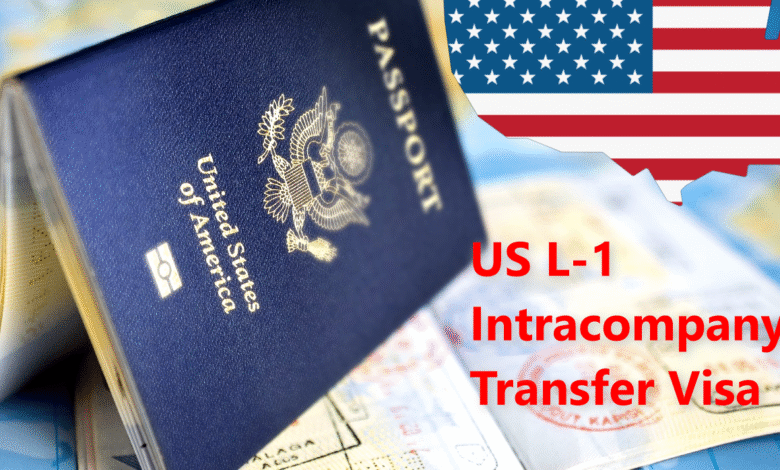US L-1 Intracompany Transfer Visa: Answers to Your Burning Questions
Let's answer US L-1 visa FAQs and explain the rules so you can feel more confident about every step of the process.

The US L-1 visa allows international employees (managers, executives, or people with special knowledge) of a company outside the US to move to their US office. Many companies use it to grow their teams across borders. Let’s answer US L-1 visa FAQs and explain the rules so you can feel more confident about every step of the process.
US L-1 visa FAQs about Visa Basics
First things first, let’s US L-1 visa FAQs about the basics of the visa:
What Is The L-1 Visa Purpose?
The L-1 visa is a type of US visa that allows companies to transfer certain employees from an office abroad to one in the US. This visa helps global businesses bring their managers or specialists to support or launch US operations. To qualify, you must have worked for a company outside the US for at least 1 year in the last 3 years.
What Is The Difference Between L-1A And L-1B Visas?
L-1A Visa
- For executives or managers
- Valid for up to 7 years
- Can lead more easily to a green card.
L-1B Visa
- For employees with special company knowledge (like products, processes, or systems)
- Valid for up to 5 years
- More limited but still allows transfer to the US.
Is The L-1 Visa Holder Allowed To Have Dual Intent?
Yes. That means you can be in the US on an L-1 visa while also applying for a green card. You don’t have to hide your plans or prove that you’ll go back home. This is a big benefit of the L-1 over some other visa types.
Are There Any Alternatives To The L-1 Visa?
There are:
- H-1B visa for skilled workers with at least a bachelor’s degree.
- O-1 visa for people with extraordinary ability in their field.
- E-2 visa for investors or business owners from treaty countries.
- EB-1C Green Card which is similar to L-1A but a direct green card option.
Is There A Cap On The Number Of L-1 Visas Issued Annually?
No. If you qualify and your paperwork is in order, there’s no need to worry about a lottery or waiting for your turn. That makes it a great option for companies needing quick, reliable transfers.
US L-1 visa FAQs about Eligibility & Requirements
There are rules both for the employee (transferee) and the US company. Let’s break them down simply:
What Are The L-1 Visa Requirements For The Transferee?
The employee must:
- Have worked for the company outside the US for at least 1 full year in the last 3 years
- Be coming to the US to work as an executive or manager (L-1A) or a person with specialized knowledge (L-1B).
- Be transferring to a US branch, parent, affiliate, or subsidiary of the same employer.
What Are The L-1 Visa Requirements For The US Company?
The US office must:
- Be related to the foreign company (like a branch, parent, or affiliate).
- Be doing business in the US and at least one other country.
- Have a real physical office in the US or be planning to set one up.
Note: For new offices, the company must show it can support the transferee within one year.
What Type Of Business Do I Need To Be To Apply For The L-1 Visa?
The type doesn’t matter. But, the business must be legally operating in both the US and abroad. There just must be a corporate link between the foreign and US entities. Startups can also apply, but they’ll need to show real plans (like leases, employees, and revenue potential).
What Kind Of Documentation Do I Need To Get My L-1 Visa Approved?
For the Employee (Transferee)
- Resume or CV
- Pay slips or tax returns from the last year
- Letter from employer explaining your role and why you’re being transferred
- Proof of specialized knowledge (if applying for L-1B)
For the Company
- Proof of the relationship between the US and foreign company (like incorporation docs)
- Business license and registrations
- Organizational charts
- Lease agreement or proof of US office
- Financial records (tax returns, bank statements, payroll, etc.)
- Business plan (for new offices)
US L-1 visa FAQs about Application & Processing
Figuring out how to apply and how long it takes is confusing. Let’s break it down so the process feels a little less overwhelming:
What Is The Normal L-1 Visa Processing Time?
For regular (standard) processing, it usually takes 1 to 3 months for USCIS to review and decide on your L-1 petition. If you’re applying through a US embassy abroad, the consular processing adds a few more weeks after approval. If your case is complicated or needs more paperwork, it might take longer.
What Is ‘Premium Processing’ And How Much Extra Will It Cost?
Premium processing is a fast-track service offered by USCIS. It gives you a decision in 15 calendar days, costs an extra $2,805, and is totally optional. To use it, you need to file Form I-907 with your L-1 application or later.
Where Should I-129 Be Filed?
It should be filed with the correct USCIS service center, based on where the US company is located and whether you’re using premium processing. You can check the current filing address on the USCIS website or ask an immigration lawyer to be safe.
Can I Apply For An L-1 Visa While In The USA?
Yes, you can. If you’re already in the US on a different visa, your employer can file a change of status with USCIS using Form I-129. But:
- You can’t leave the US until your L-1 is approved.
- If you leave the country before approval, you’ll have to apply for the L-1 at a US embassy abroad.
US L-1 visa FAQs about Changing Jobs, Status, or Employers
Questions about role shifts are common, and the rules can be strict, but let’s answer them and help you understand your options:
Can I Transfer My L-1 Visa To Another Company?
No, you can’t. It only allows you to work for the company that sponsored you. If you want to work for a different company, you’d need to:
- Apply for a different visa (like an H-1B or O-1).
- Have that new company file a new petition.
- Leave the US and re-enter on the new visa once approved (in most cases).
Can An L-1 Visa Holder Change Status Once They Are In The US?
Yes, you can change your status to H-1B, F-1, O-1 visas, and Green cards inside the US if you meet the rules for another visa. To do this, your new petition must be filed with USCIS before your current L-1 expires. Once you change status, you can’t travel outside the US without possibly needing a new visa to get back in.
What Happens If An L-1 Visa Holder’s Employment Is Terminated?
If your job ends, your visa status ends, too. In this case, you have up to 60 days or until your I-94 expires (whichever is sooner). During that time, you can:
- Find another job and apply for a new visa.
- Change your status.
- Prepare to leave the US.
- File for a B-2 tourist visa to get extra time.
US L-1 visa FAQs about Travel, Study & Work Flexibility
You’re stuck in the US, but there are rules for traveling and staying. Let’s have a quick look at what’s allowed:
Can L-1 Visa Holders Travel In And Out Of The US?
Yes, absolutely. As long as your L-1 visa is valid and your passport is current, you can leave and re-enter the US as needed. Each time you re-enter, the border officer will check your documents. So always carry:
- Your valid L-1 visa stamp
- A valid passport (at least 6 months beyond your return date)
- Your I-797 approval notice
- A copy of your job offer or employment letter
Can L-1 Visa Holders Study In The United States?
Yes, you can study part-time or take classes while on an L-1 visa. You don’t need a student visa to do this. But:
- You must continue working full-time in your L-1 role.
- Your studies can’t interfere with your job duties.
- Most people take evening or weekend classes or online courses.
Can L-1 Visa Holders Work Part-Time Or For Multiple Employers?
No, sorry. Your L-1 visa is tied only to the company that sponsored you. You can’t take a second job, can’t freelance or consult, and can’t work for a friend’s business, or even unpaid.
Can L-1 Visa Holders Start Their Own Businesses In The US?
Technically, yes. But:
- You can’t work for that business unless it’s part of your L-1 petition.
- You can’t manage it, even if you started it.
- You can’t earn income from it while on your current L-1.
If you want to run your own business legally, you’d need to switch to a different visa, like an E-2, or apply for a green card through business immigration.
US L-1 visa FAQs Family & Dependents
US L-1 holders can bring their families on L-2 visas. Families can work, study, or build a life, too. Let’s walk through what your spouse and kids can and can’t do:
Can L-1 Visa Holders Apply For Work Authorization For Their Spouses?
Yes, but only if they’re on an L-2 visa. Eligible L-2 spouses are considered “work authorized” automatically after entering the US if their I-94 shows the correct L-2S code. That means:
- No separate work permit application is needed.
- They can start working right away once that I-94 is in hand.
If the I-94 doesn’t show the correct code, spouses can still:
- File Form I-765.
- Wait about 3 to 6 months for approval.
Can L-1 Visa Holders’ Children Attend School?
Yes, children on an L-2 visa can go to school in the US just like any other child. They can:
- Attend public or private schools.
- Join after-school programs, clubs, and sports.
- Study through high school (until they turn 21 or their visa expires).
However, once they turn 21, they’ll need to switch to a student visa (F-1) if they want to stay and continue their education.
US L-1 visa FAQs Green Card & Future Options
Many people on an L-1 visa are thinking long-term. Maybe even permanent. Here’s what you need to know if you’re planning for the road ahead:
Can L-1 Visa Holders Apply For Green Cards?
L-1A visa holders can apply for a green card under the EB-1C category, which is made for multinational executives and managers. This option is fast and doesn’t require a labor certification (PERM), which saves a lot of time. The processing time is usually 12 to 18 months, and if your green card category is current, you can file Form I-140 and Form I-485 together. That means you can move forward with your permanent residency without waiting for step-by-step approvals.
L-1B holders usually apply under the EB-2 or EB-3 categories, which are for skilled or professional workers. But unlike L-1A, this path requires PERM labor certification, meaning your employer has to prove there are no qualified US workers for the job. That process takes more time and adds extra steps. Overall, the green card process for L-1B visa holders can take 2 to 3 years or more, depending on the case and government processing times.
Can L-1A Holders Or Applicants Also Apply For The H-1B Lottery?
Yes, they can, but most don’t need to. L-1A is already a strong visa with a green card potential. But if you still want to try for the H-1B, you can apply in the lottery. If selected, your employer can file Form I-129 for H-1B status. It might be useful if your L-1 is expiring and you don’t qualify for a green card yet.
Keep in mind that the H-1B has a 65,000 cap, plus 20,000 more for advanced degree holders, so it’s not guaranteed.
US L-1 visa FAQs: Let’s Recap
The L-1 visa offers a clear path for working and living in the US through your current company. With the right steps and documents, it can lead to exciting long-term options. Staying informed and prepared makes the process smoother, and every detail you learn brings you closer to your goal.











